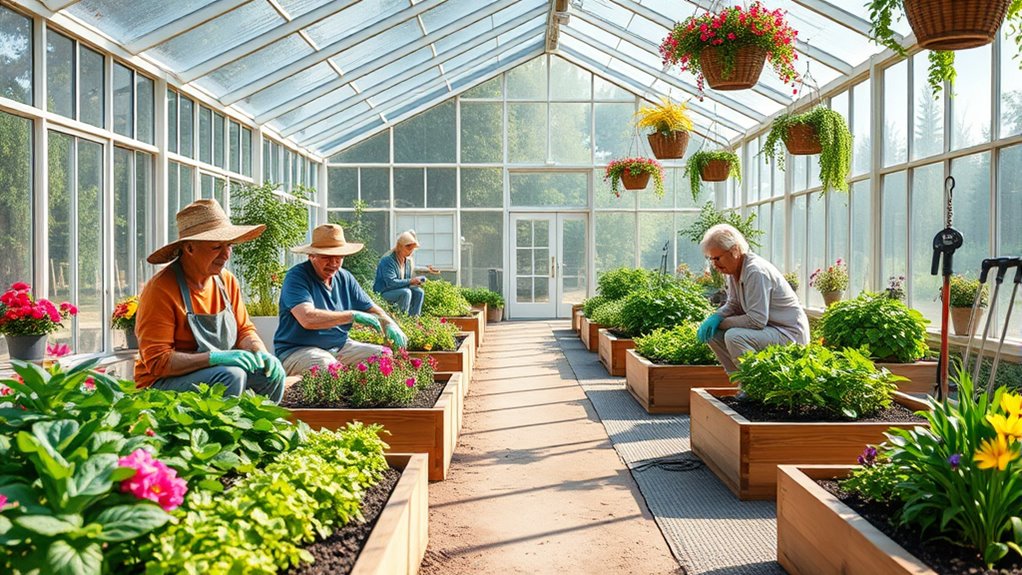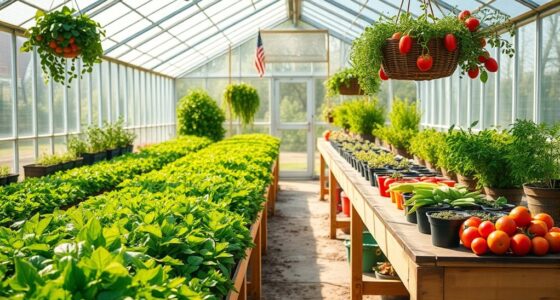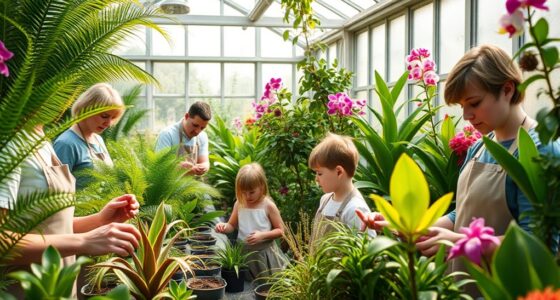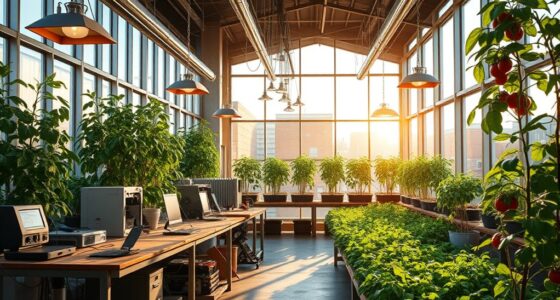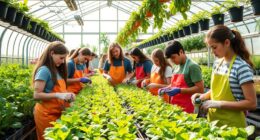Accessible gardening in greenhouses allows you to enjoy gardening safely and comfortably. With features like wide, smooth pathways, raised beds, and adjustable shelves, you can easily tend to your plants without bending or stretching too much. Ergonomic tools make planting and watering less tiring and easier on your joints. Proper lighting, ventilation, and seating areas further enhance comfort and safety. Keep exploring to discover how you can create an ideal, accessible space tailored just for you.
Key Takeaways
- Design greenhouse layouts with wide, smooth pathways and low shelving for easy wheelchair and walker access.
- Incorporate adjustable workbenches and raised beds to minimize bending and stretching.
- Use ergonomic gardening tools with lightweight handles and long reach to reduce strain.
- Ensure proper lighting, ventilation, and climate control for a comfortable, safe environment.
- Include seating and kneeling pads to support rest and prevent overexertion during gardening activities.
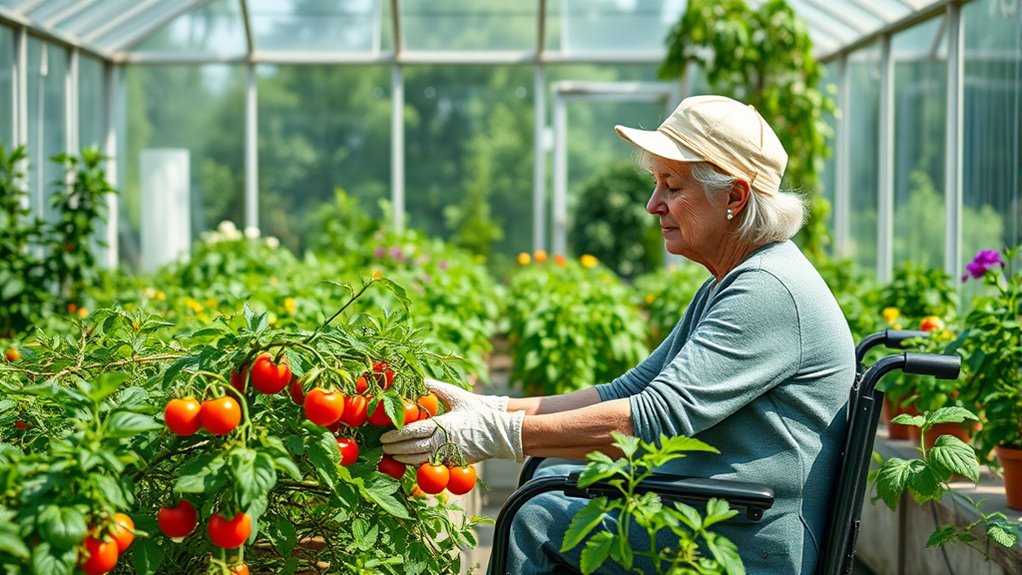
Greenhouses offer seniors a safe and controlled environment to enjoy gardening without the physical strain of traditional outdoor beds. This setting is ideal because it minimizes risks such as uneven terrain, harsh weather, and exposure to pests. When designing a greenhouse for senior gardeners, ensuring wheelchair accessibility is essential. You want to make sure pathways are wide enough for a wheelchair to move comfortably, with smooth, even surfaces that prevent tripping or getting stuck. Low shelving and raised beds are also vital, allowing you to tend to plants without needing to bend down or stretch excessively. These features help you stay independent and comfortable while gardening, making the experience more enjoyable and less physically demanding.
Using ergonomic tools is another key component to creating an accessible greenhouse for seniors. These tools are designed to reduce strain on your hands, wrists, and back, making planting, pruning, and harvesting easier. Look for lightweight, padded, or cushioned handles that fit comfortably in your grip. Long-handled tools can help you reach plants at the back of beds without stretching or twisting your body, preventing unnecessary fatigue or injury. Ergonomic tools also help you maintain better control, which is especially important if you have joint pain or limited dexterity. Incorporating these tools into your gardening routine makes tasks more manageable and less tiring, encouraging you to spend more time nurturing your plants.
In addition to physical features, consider the overall layout of your greenhouse. Keep frequently used tools and supplies within arm’s reach to minimize unnecessary movement. Seating areas or kneeling pads can provide rest when needed, helping you avoid overexertion. Adjustable shelving and workbenches allow you to customize your space based on your height and comfort level. Bright, even lighting is important to reduce eye strain and help you see details clearly, especially if your eyesight isn’t perfect. Proper ventilation and climate control maintain a comfortable environment, reducing the physical effort required to adapt to changing outdoor conditions. Researching size restrictions and local building codes before planning your greenhouse ensures that your garden space complies with legal standards and best practices.
With these elements in place, you can fully enjoy the therapeutic benefits of gardening without the physical barriers that often come with traditional outdoor beds. Accessible greenhouses empower you to cultivate your favorite plants, enjoy fresh air, and stay active in a safe, comfortable setting. By prioritizing wheelchair accessibility and ergonomic tools, you create a space that supports your independence, health, and love of gardening. This thoughtful approach transforms gardening from a strenuous activity into a relaxing, rewarding hobby that enhances your well-being and keeps you connected to nature.
Frequently Asked Questions
What Are the Best Plants for Elderly Gardeners in Greenhouses?
You should consider indoor herbs like basil, mint, and parsley, which are easy to grow and useful in cooking. Easy care succulents such as aloe vera and jade plants are perfect for seniors because they require minimal watering and maintenance. These plants boost confidence and bring joy without overwhelming effort, making gardening in greenhouses both accessible and enjoyable for elderly gardeners.
How Can I Prevent Slips and Falls in Greenhouse Gardening?
To prevent slips and falls in your greenhouse, make sure you install non-slip flooring that provides better grip and reduces hazards. Keep walkways secure and clear of obstacles, such as tools or plant debris. Regularly check for wet spots or spills and clean them promptly. Use handrails or supports where needed, and encourage proper footwear with slip-resistant soles. These steps create a safer environment for your gardening activities.
Are There Any Specific Tools Designed for Seniors?
Yes, there are specific tools designed for seniors. You should look for ergonomic tools that reduce strain and adaptive equipment that makes gardening easier and safer. These tools often feature lightweight handles, cushioned grips, and adjustable heights, helping you maintain independence while gardening. Using the right ergonomic tools and adaptive equipment minimizes discomfort, prevents injuries, and makes your greenhouse gardening experience more enjoyable and accessible.
How Can I Ensure Proper Ventilation for Senior-Friendly Greenhouses?
To guarantee proper ventilation for senior-friendly greenhouses, you should focus on improving air circulation with effective ventilation systems. Install exhaust fans and adjustable vents to promote fresh air flow and prevent overheating. Regularly open windows or vents, especially during warm days, and consider ceiling fans to circulate air gently. Proper ventilation keeps the environment comfortable and healthy, making your greenhouse a safe, enjoyable space for seniors to garden.
What Safety Measures Should I Implement for Elderly Greenhouse Gardeners?
You need to prioritize safety by implementing adaptive tools and ergonomic design in your greenhouse. Make sure pathways are clear and nonslip, reducing fall risks. Install easy-to-reach shelves and adjustable workstations to prevent strain. Use proper lighting to avoid accidents, and always keep emergency exits accessible. These measures create a secure environment, allowing elderly gardeners to enjoy their passion confidently—because nothing is more important than their safety as they nurture their green oasis.
Conclusion
By making your greenhouse accessible, you open a world of joy and independence for seniors. Imagine the warmth of the sun and the vibrant colors of blooming plants, all within reach. Isn’t it time to turn your greenhouse into a sanctuary of growth and connection? With thoughtful design, you create more than a garden—you cultivate happiness and lifelong memories. After all, the true beauty of gardening lies in sharing its simple, profound pleasures.
